Gas Exchange in a leaf
1/14
There's no tags or description
Looks like no tags are added yet.
Name | Mastery | Learn | Test | Matching | Spaced |
|---|
No study sessions yet.
15 Terms
Label the structures of a leaf

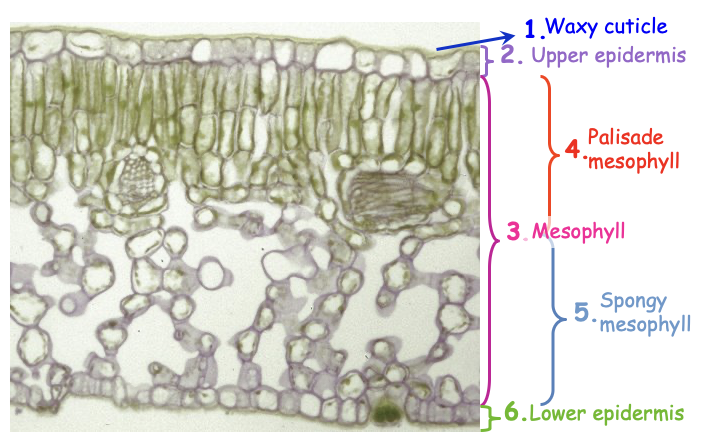
Function of Waxy Cuticle
Thick, waxy layer of leaf prevents water loss from leaf surface
Function of Upper Epidermis
Cells pack closely together for protection of internal tissues from mechanical damage and bacterial, fungal invasion
Function of Palisade Mesophyll
Columnar cells closely packed together containing lots of chloroplasts, more efficient absorption of light for increased photosynthesis
Function of Spongy Mesophyll
Irregular, loosely packed cells with lots of air space to allow rapid diffusion of gases throughout cell (CO2 for photosynthesis)
Contains some chloroplasts for photosynthesis
Function of Lower Epidermis
Contains lots of stomata for gas exchange
Function of Stomata and Guard Cells
Stomata are openings on the underside of the leaf which allows gas to enter and exit leaf
Guard Cells control the size of the stomata
Guard Cells controlling opening and closing of the stomata: Diagram and explanation
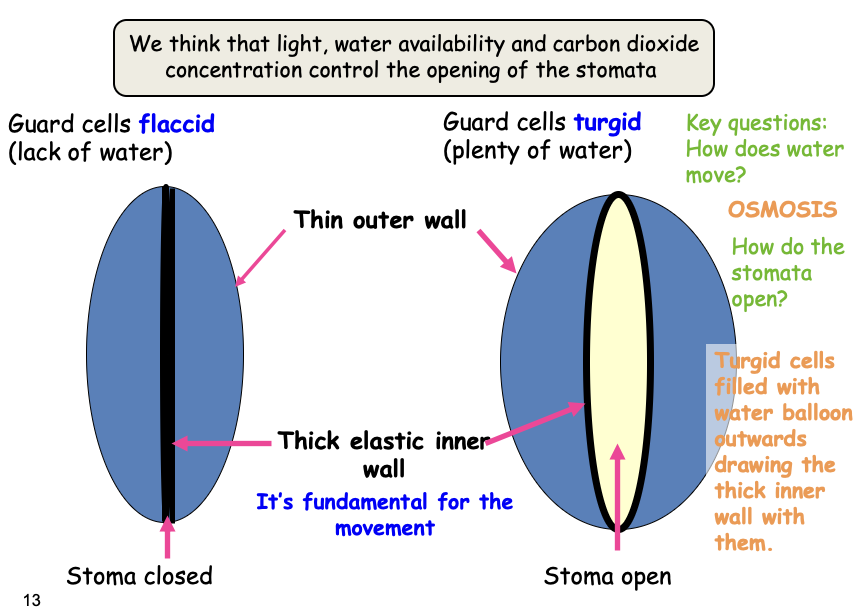
Draw a graph showing stomatal opening over 24 hours
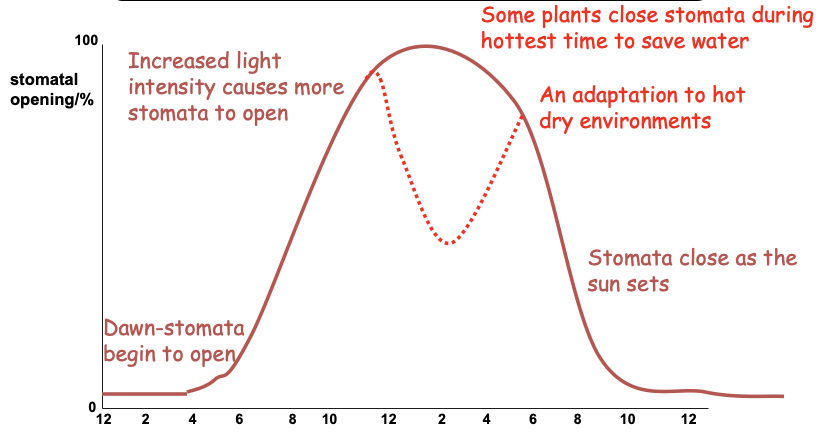
Use the graph to explain how light and water availability control the opening of the stomata (4 marks)
Any 4 of the following:
Stomata are closed when there isn’t much water in the guard cells
When water availability increases, water moves inside the guard cells via osmosis
These become turgid and because of their elastic inner wall they curve and open the stoma
With increased light intensity (from 6-12 noon) there are more guard cells opening
This allows an increase in gaseous exchange for greater rates of photosynthesis when there’s a lot of sunlight
When there’s a reduction in water availability (12-2pm)
This causes the guard cells to become increasing flaccid and close (between 2-10pm)
Regulating Stomatal Opening: Potassium ion pump hypothesis
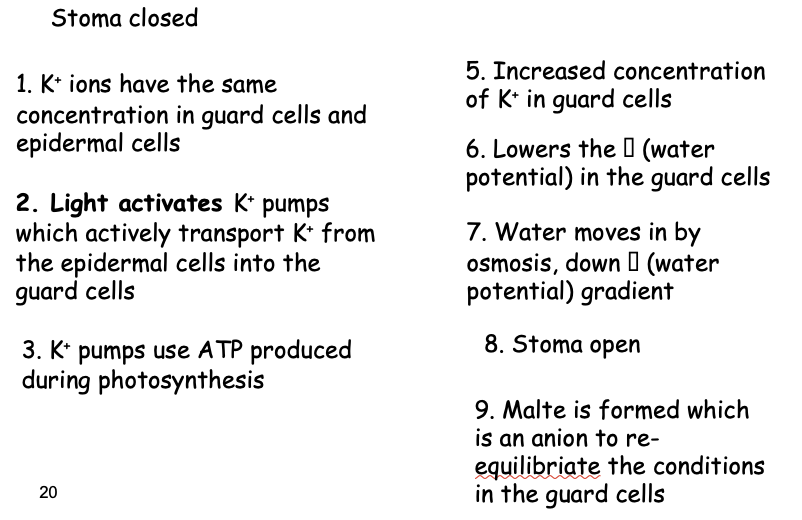
Air diffuses in and out of the leaf through pores called stomata.
The primary gas exchange surface is the surface of the ______ cells. They have air spaces between them allowing all the cells access to the gases. This provides a ______ ________ _______.
The exchange surface is _______ due to the flattened shape of the leaf and gas diffusion through the stomata (in and out) keeps the __________ __________ of gases high.
These features that make leaves efficient gas exchange also make them lose water. Leaves have some adaptations to offset this.
Air diffuses in and out of the leaf through pores called stomata.
The primary gas exchange surface is the surface of the mesophyll cells. They have air spaces between them allowing all the cells access to the gases. This provides a large surface area.
The exchange surface is thin due to the flattened shape of the leaf and gas diffusion through the stomata (in and out) keeps the concentration gradient of gases high.
These features that make leaves efficient gas exchange also make them lose water. Leaves have some adaptations to offset this.
Gas exchange in plants summary: day and night
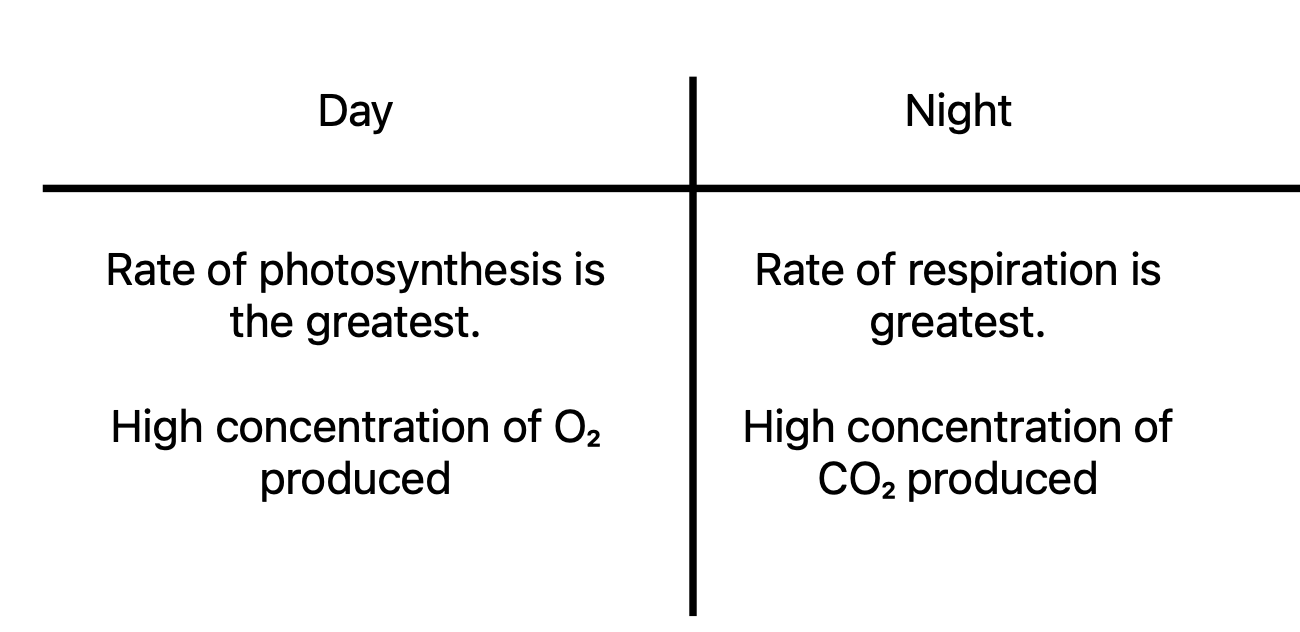
Describe 8 Xerophytic adaptations
Thick cuticle
Small leaf SA:vol ratio
Low Stomata density
Sunken Stomata
Stomatal hairs (trichores)
Rolled leaves
Extensive roots
Densely packed mesophyll
Explain the 8 Xerophytic adaptations
Thick cuticle - water resistance to prevent evaporation of water
Small leaf surface area to volume ratio - fewer stomata, less loss of water
Low stomata density, less water loss by evaporation
Sunken stomata, less steep water potential gradient between the leaf and air
Stomatal hairs (trichores) trap moist air, less steep water potential gradient between the leaf and air
Rolled leaves helps traps a region of still air within the rolled leaf - this region has high water potential. There’s no water potential between in and outside leaf so no water loss
Extensive roots, minimises water loss
Densely packed mesophyll - helps prevent water loss via evaporation